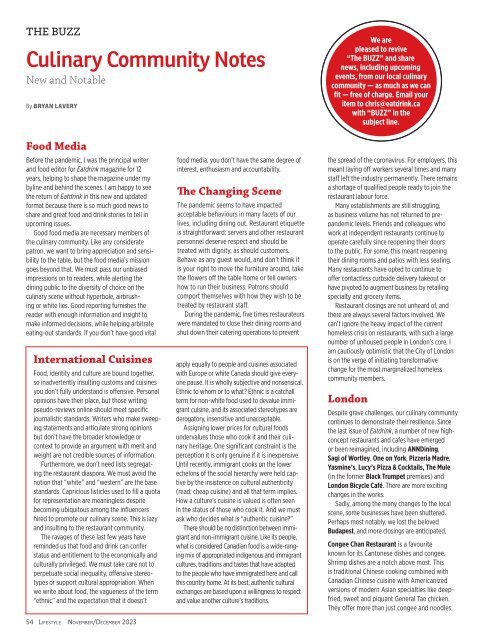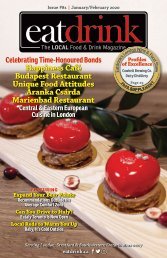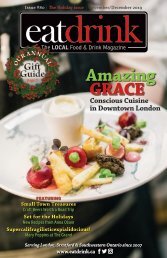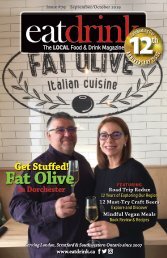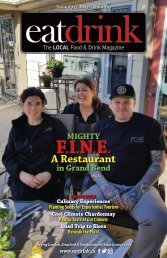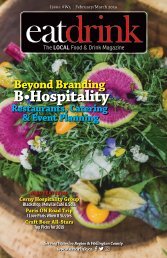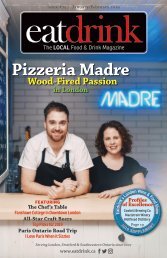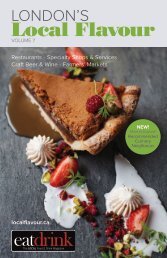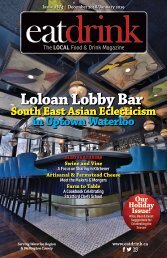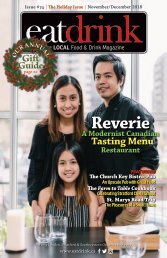Create successful ePaper yourself
Turn your PDF publications into a flip-book with our unique Google optimized e-Paper software.
THE BUZZ<br />
Culinary Community Notes<br />
New and Notable<br />
By BRYAN LAVERY<br />
We are<br />
pleased to revive<br />
“The BUZZ” and share<br />
news, including upcoming<br />
events, from our local culinary<br />
community — as much as we can<br />
fit — free of charge. Email your<br />
item to chris@eatdrink.ca<br />
with “BUZZ” in the<br />
subject line.<br />
Food Media<br />
Before the pandemic, I was the principal writer<br />
and food editor for Eatdrink magazine for 12<br />
years, helping to shape the magazine under my<br />
byline and behind the scenes. I am happy to see<br />
the return of Eatdrink in this new and updated<br />
format because there is so much good news to<br />
share and great food and drink stories to tell in<br />
upcoming issues.<br />
Good food media are necessary members of<br />
the culinary community. Like any considerate<br />
patron, we want to bring appreciation and sensibility<br />
to the table, but the food media’s mission<br />
goes beyond that. We must pass our unbiased<br />
impressions on to readers, while alerting the<br />
dining public to the diversity of choice on the<br />
culinary scene without hyperbole, airbrushing<br />
or white lies. Good reporting furnishes the<br />
reader with enough information and insight to<br />
make informed decisions, while helping arbitrate<br />
eating-out standards. If you don’t have good vital<br />
International Cuisines<br />
Food, identity and culture are bound together,<br />
so inadvertently insulting customs and cuisines<br />
you don’t fully understand is offensive. Personal<br />
opinions have their place, but those writing<br />
pseudo-reviews online should meet specific<br />
journalistic standards. Writers who make sweeping<br />
statements and articulate strong opinions<br />
but don’t have the broader knowledge or<br />
context to provide an argument with merit and<br />
weight are not credible sources of information.<br />
Furthermore, we don’t need lists segregating<br />
the restaurant diaspora. We must avoid the<br />
notion that “white” and “western” are the base<br />
standards. Capricious listicles used to fill a quota<br />
for representation are meaningless despite<br />
becoming ubiquitous among the influencers<br />
hired to promote our culinary scene. This is lazy<br />
and insulting to the restaurant community.<br />
The ravages of these last few years have<br />
reminded us that food and drink can confer<br />
status and entitlement to the economically and<br />
culturally privileged. We must take care not to<br />
perpetuate social inequality, offensive stereotypes<br />
or support cultural appropriation. When<br />
we write about food, the vagueness of the term<br />
“ethnic” and the expectation that it doesn’t<br />
food media, you don’t have the same degree of<br />
interest, enthusiasm and accountability.<br />
The Changing Scene<br />
The pandemic seems to have impacted<br />
acceptable behaviours in many facets of our<br />
lives, including dining out. Restaurant etiquette<br />
is straightforward: servers and other restaurant<br />
personnel deserve respect and should be<br />
treated with dignity, as should customers.<br />
Behave as any guest would, and don’t think it<br />
is your right to move the furniture around, take<br />
the flowers off the table home or tell owners<br />
how to run their business. Patrons should<br />
comport themselves with how they wish to be<br />
treated by restaurant staff.<br />
During the pandemic, five times restaurateurs<br />
were mandated to close their dining rooms and<br />
shut down their catering operations to prevent<br />
apply equally to people and cuisines associated<br />
with Europe or white Canada should give everyone<br />
pause. It is wholly subjective and nonsensical.<br />
Ethnic to whom or to what? Ethnic is a catchall<br />
term for non-white food used to devalue immigrant<br />
cuisine, and its associated stereotypes are<br />
derogatory, insensitive and unacceptable.<br />
Assigning lower prices for cultural foods<br />
undervalues those who cook it and their culinary<br />
heritage. One significant constraint is the<br />
perception it is only genuine if it is inexpensive.<br />
Until recently, immigrant cooks on the lower<br />
echelons of the social hierarchy were held captive<br />
by the insistence on cultural authenticity<br />
(read: cheap cuisine) and all that term implies.<br />
How a culture’s cuisine is valued is often seen<br />
in the status of those who cook it. And we must<br />
ask who decides what is “authentic cuisine?”<br />
There should be no distinction between immigrant<br />
and non-immigrant cuisine. Like its people,<br />
what is considered Canadian food is a wide-ranging<br />
mix of appropriated indigenous and immigrant<br />
cultures, traditions and tastes that have adapted<br />
to the people who have immigrated here and call<br />
this country home. At its best, authentic cultural<br />
exchanges are based upon a willingness to respect<br />
and value another culture’s traditions.<br />
the spread of the coronavirus. For employers, this<br />
meant laying off workers several times and many<br />
staff left the industry permanently. There remains<br />
a shortage of qualified people ready to join the<br />
restaurant labour force.<br />
Many establishments are still struggling,<br />
as business volume has not returned to prepandemic<br />
levels. Friends and colleagues who<br />
work at independent restaurants continue to<br />
operate carefully since reopening their doors<br />
to the public. For some, this meant reopening<br />
their dining rooms and patios with less seating.<br />
Many restaurants have opted to continue to<br />
offer contactless curbside delivery takeout or<br />
have pivoted to augment business by retailing<br />
specialty and grocery items.<br />
Restaurant closings are not unheard of, and<br />
there are always several factors involved. We<br />
can’t ignore the heavy impact of the current<br />
homeless crisis on restaurants, with such a large<br />
number of unhoused people in London’s core. I<br />
am cautiously optimistic that the City of London<br />
is on the verge of initiating transformative<br />
change for the most marginalized homeless<br />
community members.<br />
London<br />
Despite grave challenges, our culinary community<br />
continues to demonstrate their resilience. Since<br />
the last issue of Eatdrink, a number of new highconcept<br />
restaurants and cafes have emerged<br />
or been reimagined, including ANNDining,<br />
Sagi of Wortley, One on York, Pizzeria Madre,<br />
Yasmine’s, Lucy’s Pizza & Cocktails, The Mule<br />
(in the former Black Trumpet premises) and<br />
London Bicycle Café. There are more exciting<br />
changes in the works.<br />
Sadly, among the many changes to the local<br />
scene, some businesses have been shuttered.<br />
Perhaps most notably, we lost the beloved<br />
Budapest, and more closings are anticipated.<br />
Congee Chan Restaurant is a favourite<br />
known for its Cantonese dishes and congee.<br />
Shrimp dishes are a notch above most. This<br />
is traditional Chinese cooking combined with<br />
Canadian Chinese cuisine with Americanized<br />
versions of modern Asian specialties like deepfried,<br />
sweet and piquant General Tao chicken.<br />
They offer more than just congee and noodles.<br />
54 LifestyLe LIFESTYLE November/December FEATURING EATDRINK 2023 NOVEMBER/DECEMBER 2023


